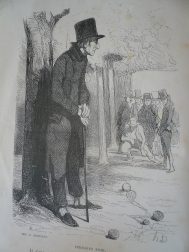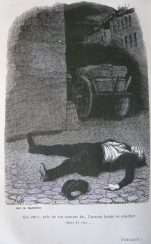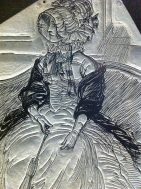
The Thirteen – Ferragus
THE HUMAN COMEDY – Honoré de Balzac Ninth volume of works of Honoré de Balzac edited by widow André Houssiaux, publisher, Hebert and Co, successors, 7 rue Perronet – Paris (1877) Scenes from Parisian life

Ferragus, leader of the devourers
HISTORY OF THE THIRTEEN Novel in 3 episodes under the titles: Ferragus, La Duchesse de Langeais, La Fille aux yeux d’or
FERRAGUS
Analysis of the work L’Histoire des treize is the first of our scenes of Parisian life. This famous division of La Comédie Humaine has a date of birth. Although the first two episodes ofHistoire des treize appeared in March 1833, it was not until the end of the year, in December 1833, that Scènes de la vie parisienne made its entry in Balzac’s nomenclature. On this date, he signed a treaty with Mme Vve Béchet, which brought together under the general title ofEtudes de mœurs du XIXe siècle all the descriptive works he had published to that date, and those he planned to add. This first presentation of Balzac’s works was divided into three series: Scènes de la vie privée, Scènes de la vie de province and Scènes de la vie parisienne. Each of these divisions was to comprise four in-8° volumes. Balzac had not written a single Scène de la vie parisienne (with the exception of the two episodes ofHistoire des treize) when he boldly signed this commitment. It didn’t matter to him. He was able to publish one of the promised four volumes as early as April 1834, simply by naming a number of the short stories that had previously appeared under the heading Scènes de la vie parisienne. This transfer is just one of many examples of Balzac’s working methods. The significance of Scènes de la vie parisienne was explained by Balzac in theIntroduction aux études de mœurs au XIXe siècle, which he commissioned his friend Félix Davin to write in 1835. He describes them as a series of dramatic novels in which the cynicism and greed that reign in large human agglomerations are depicted: “Here, true feelings are exceptions and are shattered by the play of interests, crushed between the cogs of this mechanical world: virtue is slandered, innocence is sold, passions give way to ruinous tastes and vices, everything is subtly analyzed, sold and bought; it’s a bazaar where everything is quoted; calculations are made in broad daylight and without modesty, humanity now has only two forms, the deceiver and the deceived… ” And Balzac made it clear in the same place that Scènes de la vie parisienne would show mostly old men, i.e. men whose inveterate passions have become demanding obsessions, fixed ideas to which one is ready to sacrifice everything. There was obviously a contradiction in transferring Scenes from Parisian Life to Scenes from Private Life, which had originally been intended to show the faults that young people commit through levity at the beginning of their lives. This contradiction not only shows us Balzac’s casualness, it also warns us that Balzac didn’t imagine the true character of the Scènes de la vie parisienne he had undertaken to write until two years later, without knowing exactly what their content would be. In fact, it was while writing Père Goriot, in 1834, that Balzac understood what these Scenes from Parisian Life were to be.  L’Histoire des treize, the first of the Scènes de la vie parisienne series, certainly doesn’t fit Balzac’s 1835 definition of the series. It is nonetheless a significant “overture” to these Scenes. For it is first and foremost a presentation of Paris. L’Histoire des treize reveals “the mysteries of Paris”. The subject, for a start. It’s the story of a mafia: thirteen men who, through their selfishness, audacity and discipline, and by observing – as all mafias do – the law of silence, theomerta, arrange careers and fortunes, impose punishments and exact revenge. Balzac goes to great lengths, even writing an entire preface, to inform his readers that such organizations did exist: in reality, he wants to persuade them that they know nothing about the secret underbelly of Parisian society, the backstage world into which the author is about to take them. But this exploration will also show them that they can’t see: they’re blind walkers. In Paris, at any given moment, there are riddles whose meaning escapes them, passers-by they don’t recognize, and above all caverns, all sorts of caverns they pass by every day without suspecting them. And Balzac takes them into these caves, a porter’s lodge, a garret that’s a refuge, a bachelor pad in the luxurious Saint-Lazare district that’s an inaccessible seraglio better guarded than that of a sultan. It was at this time, too, that Balzac developed a special vocabulary that he would later use to characterize Parisian fauna. ( see Splendeurs et misères des courtisanes in Volume III)
L’Histoire des treize, the first of the Scènes de la vie parisienne series, certainly doesn’t fit Balzac’s 1835 definition of the series. It is nonetheless a significant “overture” to these Scenes. For it is first and foremost a presentation of Paris. L’Histoire des treize reveals “the mysteries of Paris”. The subject, for a start. It’s the story of a mafia: thirteen men who, through their selfishness, audacity and discipline, and by observing – as all mafias do – the law of silence, theomerta, arrange careers and fortunes, impose punishments and exact revenge. Balzac goes to great lengths, even writing an entire preface, to inform his readers that such organizations did exist: in reality, he wants to persuade them that they know nothing about the secret underbelly of Parisian society, the backstage world into which the author is about to take them. But this exploration will also show them that they can’t see: they’re blind walkers. In Paris, at any given moment, there are riddles whose meaning escapes them, passers-by they don’t recognize, and above all caverns, all sorts of caverns they pass by every day without suspecting them. And Balzac takes them into these caves, a porter’s lodge, a garret that’s a refuge, a bachelor pad in the luxurious Saint-Lazare district that’s an inaccessible seraglio better guarded than that of a sultan. It was at this time, too, that Balzac developed a special vocabulary that he would later use to characterize Parisian fauna. ( see Splendeurs et misères des courtisanes in Volume III)
FERRAGUS – Chief of the devourers In the novel about Ferragus, Balzac compares his acrobats of fortune to the privateers celebrated by Lord Byron in his poems. Byron had turned the privateer into a romantic hero, both a rebel and an adventurer who sought a dangerous escape from the flat, conventional existence of English youth in the days of the Hanoverian dynasty. Balzac transforms these enemies of propriety into enemies of the law. He transposes these “rebels” to Parisian life. He turns them into avengers, then cynics, who, having placed themselves above the law in order to punish, maintain themselves there by their union. Hence the image first mentioned in the preface toHistoire des treize, that of the “freebooters in yellow gloves and carriages” who would soon become the “privateers in yellow gloves” so often cited in La Comédie Humaine. Another characteristic of these “lives of opposition” is also set out for the first time in this same preface. This is the reference made “to the sublime union of Pierre and Jaffier” in Otway’s Venice Saved. Balzac had long admired this play by Thomas Otway, a famous 17th-century English dramatist. He already cites it in his The physiology of marriage and again in The skin of sorrow. But this is the first time he has pointed out, as the most striking image of this tragi-comedy, this fraternal union between two outlaws, which seems to him one of the most beautiful and solid pacts that can exist between men. For him, it is the symbol of “particular virtues”, of people thrown out of the social order, it highlights “the probity of prisons”, the “fidelity of thieves among themselves”, and finally the “exorbitant power” that men can acquire by combining their forces “in a single will”. Balzac even says in his preface, “dramas dripping with blood, comedies full of terror, novels where secretly severed heads roll”. This promise shows just how far removed these melodramatic episodes are from the later definition of Scènes de la vie parisienne . This profession of faith was not fulfilled to the letter. There are no “secretly severed heads” in theHistory of the Thirteen, but there are, indeed, dramas of terror. Above all, the situations often resemble those of melodrama. The first episode, Ferragus, chef des dévorants, is the story of an escaped convict. Bourignard, also known as “Ferragus”, is the leader of the two major Compagnonnage organizations, the Compagnons du Devoir, or “Companions of Duty”. Disclaimers or Devourers, which opposed the Compagnons du Devoir de Liberté, called Gavots. This escaped convict has immense resources at his disposal, and is received around the world with a title and a diplomatic function. He orders the assassination of a young, elegant Baron de Maulaincour who has the misfortune to learn his secret. This retaliation operation ends very badly. The result is the despair and death of the beloved daughter of the almighty Ferragus, who, shattered by her death, abdicates his kingship and ends up as a wreck in the old people’s home at Bicêtre. What’s most disturbing about this detective story is that Ferragus had as accomplices in this operation men we’ll find in the highest ranks of society throughout Scènes de la vie parisienne.

Madame Jule
The story Ferragus tells the story of the love of a young officer, Auguste de Maulincour, for the beautiful Madame Clémence Desmarets, wife of a wealthy stockbroker. Auguste loves Clémence with a secret, all-consuming passion. As Auguste strolls through an unsavory part of Paris, he is surprised to spot Clémence. Surprised by his beloved’s presence in this part of Paris, he begins to suspect her of his intentions, and assumes she has some unmentionable secret. He was all the more disturbed because Madame Desmarets was a model of honesty and high principles in the social circle of Paris. Finding his idol at a party given by Madame de Nucingen, he assails Clémence with innuendos about her presence in the lower quarters of the capital, in an attempt to learn more about her mystery. Very embarrassed, Clémence defends herself against this accusation with a dismissive denial. Auguste decides to unravel the mystery surrounding the young woman by spying on her. Shortly afterwards, the young man suffered several life-threatening incidents and accidents. He eventually discovers that Clémence is secretly visiting a man who is none other than an escaped convict. Auguste meets Jules Desmarets to tell him about his wife’s relationship with the man she’s been hiding. The poison of suspicion takes hold in the household of this couple who until then had adored each other. Day after day, it distills distrust and suspicion, in short, all the sorrows fertilized by the soil of dissimulation that now flourishes in the sphere of the two spouses. When Jules discovers that the man Clémence secretly loves is none other than her father, who is actually wanted by the law, it will be too late to save Clémence, who will succumb to the grief of not having been able to confess her paternal love to her husband – a hidden love, since her father is none other than Ferragus, the leader of the devourers.
The characters Auguste de Maulincour: Officer in the Garde Royale and only son of the Charbonnon de Maulincour family. Raised by his grandmother from the nobility, he frequented the faubourg Saint-Germain. Ferragus: Gratien-Victor-Jean-Joseph Bourignard, known as Ferragus XXIII, husband of Mme Etienne Gruget, parents of Clémence. Clémence Desmarets: 1795 – 1819 wife of Jules Desmarets, stockbroker. An adulterous child with no assets and no civil status, her name Clémence and her age were established by an act of public notoriety. His mother will assume the identity of godmother for the World. Jules Desmarets: Stockbroker to Monsieur de Nucingen and owner of his own stockbroker’s office. Handsome man, high personal dignity, nobility of heart. Ida: Seduced and abandoned by Gabriel-Henri Bourignard, this young girl suffers through her mistaken love. A disgraced woman, weeping for love and living in squalor, she couldn’t bear her banishment and committed suicide by drowning.
1) Source analysis/history: Preface collected (Tome XII) from the complete works of the Comédie Humaine published by France Loisirs 1986 under the auspices of the Société des Amis d’Honoré de Balzac.
2) Source for characters: Wikipedia universal encyclopedia.
No Comments